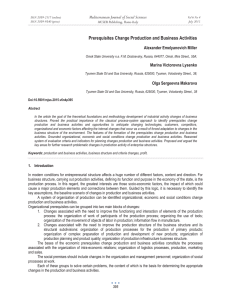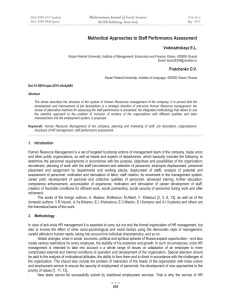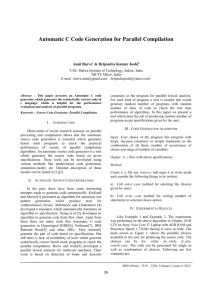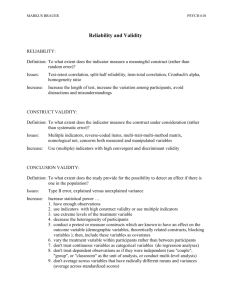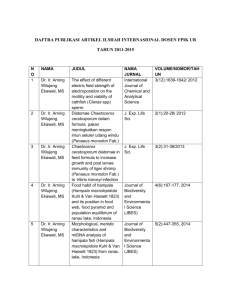Structural Equation Modeling - Related Articles Using Structural
advertisement
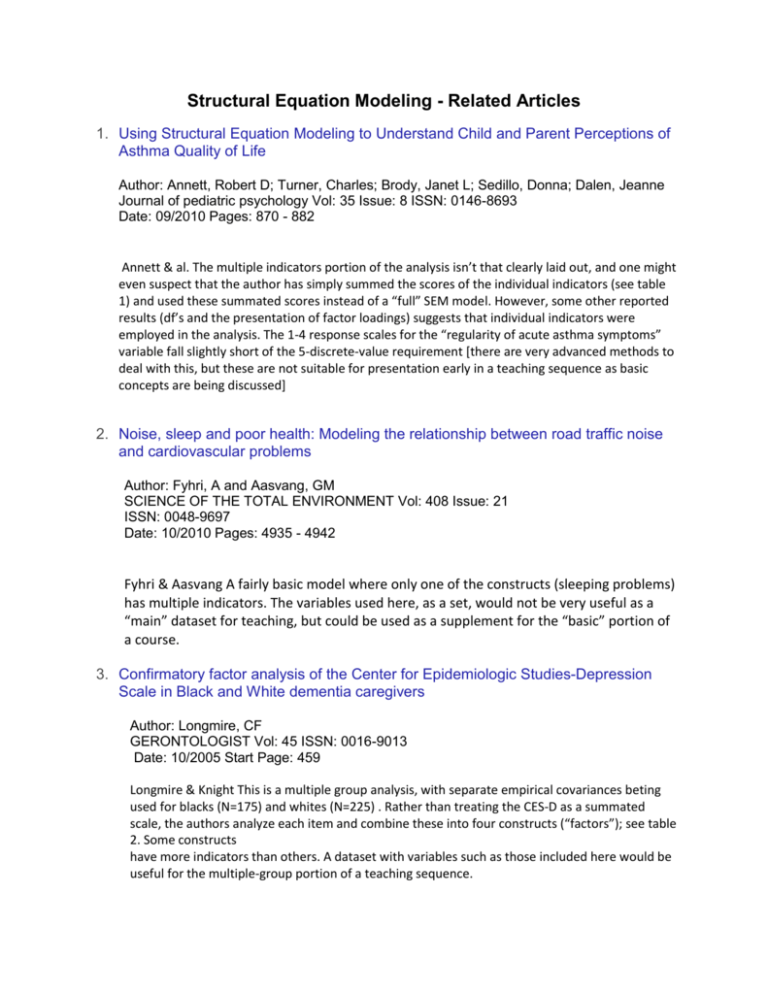
Structural Equation Modeling - Related Articles 1. Using Structural Equation Modeling to Understand Child and Parent Perceptions of Asthma Quality of Life Author: Annett, Robert D; Turner, Charles; Brody, Janet L; Sedillo, Donna; Dalen, Jeanne Journal of pediatric psychology Vol: 35 Issue: 8 ISSN: 0146-8693 Date: 09/2010 Pages: 870 - 882 Annett & al. The multiple indicators portion of the analysis isn’t that clearly laid out, and one might even suspect that the author has simply summed the scores of the individual indicators (see table 1) and used these summated scores instead of a “full” SEM model. However, some other reported results (df’s and the presentation of factor loadings) suggests that individual indicators were employed in the analysis. The 1-4 response scales for the “regularity of acute asthma symptoms” variable fall slightly short of the 5-discrete-value requirement [there are very advanced methods to deal with this, but these are not suitable for presentation early in a teaching sequence as basic concepts are being discussed] 2. Noise, sleep and poor health: Modeling the relationship between road traffic noise and cardiovascular problems Author: Fyhri, A and Aasvang, GM SCIENCE OF THE TOTAL ENVIRONMENT Vol: 408 Issue: 21 ISSN: 0048-9697 Date: 10/2010 Pages: 4935 - 4942 Fyhri & Aasvang A fairly basic model where only one of the constructs (sleeping problems) has multiple indicators. The variables used here, as a set, would not be very useful as a “main” dataset for teaching, but could be used as a supplement for the “basic” portion of a course. 3. Confirmatory factor analysis of the Center for Epidemiologic Studies-Depression Scale in Black and White dementia caregivers Author: Longmire, CF GERONTOLOGIST Vol: 45 ISSN: 0016-9013 Date: 10/2005 Start Page: 459 Longmire & Knight This is a multiple group analysis, with separate empirical covariances beting used for blacks (N=175) and whites (N=225) . Rather than treating the CES-D as a summated scale, the authors analyze each item and combine these into four constructs (“factors”); see table 2. Some constructs have more indicators than others. A dataset with variables such as those included here would be useful for the multiple-group portion of a teaching sequence. 4. Dynamic associations between maternal depressive symptoms and adolescents' depressive and externalizing symptoms Author: Kouros, Chrystyna D and Garber, Judy Journal of abnormal child psychology Vol: 38 Issue: 8 ISSN: 0091-0627 Date: 11/2010 Pages: 1069 - 1081 Kouros & Garber A good example of a “growth curve” model albeit one with single (as opposed to multiple) indicator constructs. If the author would have had access to individual items in the scales (the child depressive inventory and the Mother’s Beck Depression inventory), the dataset presented here might have been ideal as a teaching vehicle for more advanced portions of an SEM course (longitudinal data, growth curve models, etc.) 5. An Information-Motivation-Behavioral Skills Analysis of Diet and Exercise Behavior in Puerto Ricans with Diabetes Author: Osborn, Chandra Y; Rivet Amico, K; Fisher, William A; Egede, Leonard E; Fisher, Jeffrey D Journal of health psychology Vol: 15 Issue: 8 ISSN: 1359-1053 Date: 11/2010 Pages: 1201 - 1213 Osborn & al. A very simple model, with at most 2 indicators for the multiple-indicator constructs. A dataset containing the variables in this analysis would not be particularly useful for teaching purposes, though the model does show what sorts of health behaviour models could be estimated. 6. Structural model for osteoporosis preventing behavior in men Author: Doheny, Margaret O; Sedlak, Carol A; Hall, Rosalie J; Estok, Patricia J American journal of men's health Vol: 4 Issue: 4 ISSN: 1557-9883 Date: 12/2010 Pages: 334 - 343 Doheny & al. Note that the main model involves 2 constructs: health belief and general knowledge, each with a number of indicators. These constructs are only presented at one time point, while the “daily calcium” variable is measured over time and used as such in the model (there are slightly better modeling strategies that could have been used – the important thing here is that this is an example of longitudinal data, albeit not as good as longitudinal variable with multiple indicator constructs each measured at multiple points in time 7. Evaluation of a conceptual model based on Mishel's theories of uncertainty in illness in a sample of Taiwanese parents of children with cancer: A cross-sectional questionnaire survey Author: Lin, Lin; Yeh, Chao-Hsing; Mishel, Merle H International journal of nursing studies Vol: 47 Issue: 12 ISSN: 0020-7489 Date: 12/2010 Pages: 1510 - 1524 Lin & al. See Figure 2, which diagrams the variables used and shows how these are used in the analysis. Coping is a multiple indicator construct, as is “perceived social support (note the circles). Data of the sort used by the author might be useful for “basic” portions of a course. 8. Longitudinal associations between post-traumatic distress and depressive symptoms following a traumatic event: a test of three models Author: Stein, M; Shahar, G; Aderka, I. M; Schindel-Allon, I; Gilboa-Schechtman, E Psychological Medicine Vol: 40 Issue: 10 ISSN: 0033-2917 Date: 10/2010 Pages: 1669 - 1678 Schindel-Allon & al. The diagram in Figure 1 suggests that there are just 2 variables measured at 3 time points, but in fact each of the 2 variables (at each time point) has multiple indicators (see table 3): depression has 2 and PTSD has 3. Note that a construct/factor/latent variable with only 2 indicators is not nearly as good, especially for teaching purposes (2-indicator models can be unstable and discussing how to deal with this is a nice “advanced” topic but one would not wish to encounter/have to deal with the issue early in a teaching sequence). 9. A structural equation model relating work stress, coping resource, and quality of life among chinese medical professionals Author: LI, Jian; Wang, Xiaorong; Wu, Siying; Li, Huangyuan; Zhu, Wei American Journal of Industrial Medicine Vol: 53 Issue: 11 ISSN: 0271-3586 Date: 11/2010 Pages: 1170 - 1176 Wu & al. A single-time multiple-indicator model with many indicators for each of the 4 main constructs. 10. Testing a Model of Physical and Psychological Recovery After a Cardiac Event Author: Yates, Bernice C; Kosloski, Karl; Kercher, Kyle; Dizona, Paul Western journal of nursing research Vol: 32 Issue: 7 ISSN: 0193-9459 Date: 11/2010 Pages: 871 - 893 Yates & al. See Figure 2. Most constructs have multiple indicators (though three of them only have 2 indicators)
